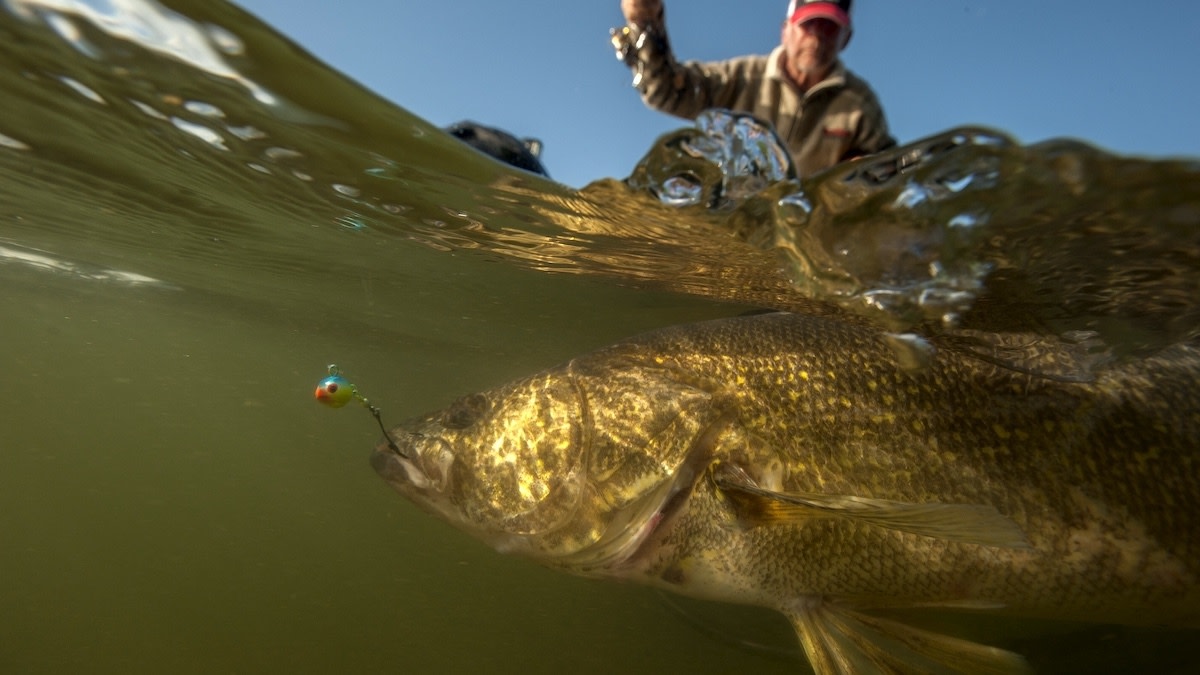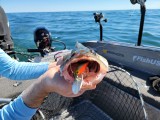
Walleye fishing seemed so simple back when grandpa first showed you how to put a worm on a hook. That was a damned effective tactic, too.
These days, as you’re walking the tackle shop aisles or scrolling endless pages of online gear sites, any thoughts that this type of fishing is a simple affair go out the window.
While anglers are prone overcomplicate things, having an arsenal of different lure types and tactics makes you a more versatile and effective walleye angler when conditions change or you travel to a new body of water. Here are five primary categories of lures, baits, and tactics for catching walleye: jigs, crankbaits, spinners, soft plastics, and live bait rigs.
Best Walleye Jigs Legendary angler Al Lindner has said for decades that if he could only use one lure for all species and seasons it would be a jig. While none of us want to be limited to one tactic, Lindner’s statement speaks volumes.
Jigs are among the simplest lures, consisting of a hook with a molded lead head. The eye for line attachment is usually set at a 90- or 45-degree angle from the hook shank so the lure sits horizontally in the water. Lead heads vary in shape, often resembling balls, cones, caps, darts, footballs, blades, fish heads, and more. Anglers will usually “tip” jigs with live or dead minnows, worms, and leeches, or with soft plastic bodies and tails.
Jigs can be fished vertically—what most folks would call “jigging”—by dropping to the bottom and bouncing up and down. You can also cast a jig and retrieve it through any part of the water column by varying your reeling speed. It’s also very effective to cast out, allow the jig to sink to the bottom, then hop it back along the substrate.
Jigs have changed a lot since Al Lindner started fishing with them. Today’s space-age lures often include ultraviolet finishes, lifelike eyes, and literally razor-sharp hooks. While you could argue the effectiveness of eyes and crazy colors, most serious anglers agree that hooks improvement is the biggest advancement we’ve seen.
Jigs such as the Northland Fire-Ball are now available in a super short-shank, wide-gap hook models. This is really helpful when you need a compact package for small fish, when using smaller live bait, or if the walleye are just plain being lethargic. This setup has been a killer on the walleye tours for decades.
Recently, tackle companies have started offering long-shank hook models as well. Long-shank jigs excel when you either want to include some type of soft plastic on the shank for color or action. More shank length allows you to still tip the hook with live bait too. These jigs are perfect for my personal favorite tactic—threading a shiner minnow onto the hook by going in the mouth, out the gills, and back in under the dorsal fin.
Don’t like live bait? No worries. These updated jigs have hooks large enough that you can thread on large soft plastics swimbaits and still have enough gap to get even the boniest mouth walleye hooked up.
Aside from all those fancy colors, make sure to stock up in sizes as small as 1/16 oz. to as large as ½ oz. to cover yourself in any depth or current you may face.
Best Walleye Soft Plastics The conversion of most walleye fisherman away from live bait has been slow. If we’re being honest, in many cases that’s for a good reason: live bait is tough to beat. There are many circumstances, however, when soft plastics just work better or help make live bait more appealing.
Soft plastics do wonders for slowing the decent of a jig. So, even if you still plan to use a minnow as well, adding a plastic-bodied bait to the hook will help slow the fall rate and often draw more bites, particularly in cold water. Inversely, in warmer water, when “snap jigging” fast and aggressively or covering structure like weed beds, live bait can come off on literally every cast. This is an expensive and inefficient proposition.
Some of the most popular and versatile plastic options include the classic twister tail grubs, paddle tail minnows, boot tail swimbaits, and flukes. These tails make the lure wobble and emanate vibration in the water. In rivers across the country, a 4-inch ring worm just always seems to be a player. More recently, anglers have been using small finesse minnows similar to those that bass anglers use for drop shotting. My favorite color is white, but other situations may dictate gray, green, blue, purple, or even chartreuse.
Best Walleye Crankbaits MeatEater’s Fishing Editor Sam Lungren defined a crankbait as: “a lure constructed of hard, molded plastic or wood, most often balsa wood, usually in the shape of a small fish. Most models have a “lip”—a piece of clear plastic or metal that extends forward and downward from the front of the lure body—which forces the lure to dive downward in the water and wiggle side to side as you retrieve or troll it.”
While that description may have been originally directed towards bass, it holds perfectly true for walleye as well. While popular bass models are often shorter and fatter, many of the most popular walleye crankbaits are thinner and longer to better represent the species of baitfish walleyes prefer.
Lip types will vary widely. Shallow crankbaits have small, wide lips designed for a more subtle wobble and shallow diving. Deep diving cranks have long bills that can dig to further down, some going to depths in excess of 30 feet. In many cases, these crankbaits are light weight and don’t cast well since they’re designed to be trolled. Some situations may call for casting crankbaits though, when walleye are up shallow in the spring or fall.
Overwhelmingly, walleye crankbaits are floaters—meaning they sit on the surface until cranked down and will slowly rise back up on slack line. A sub-category is suspending crankbaits. These lures are perfectly weighted for neutral buoyancy, so they will hover at whatever depth you troll or crank them to. These are players when fish are lethargic or just about any time water temperatures are below 50 degrees.
There are countless great crankbaits on the market, but probably my favorite is the Northland Rumble Stick in the “sneeze” color. It’s a good idea to change your lure color according to water clarity and local baitfish forage.
Best Walleye Spinners If you are less than 50 years old, chances are you call them spinner rigs. Older than 50, you might refer to them as crawler harnesses. Regardless of name preference, these rigs incorporate a leader of monofilament or fluorocarbon line with one or two snelled octopus-style hooks. Snelling is any of several types of knots that are tied around the hook shank instead of back around the line, which holds the hook at the right angle for sticking fish. Spinner rigs are usually dressed up with beads or foam bodies for some color and to act as spacers for the spinner blade that rides above it on a rotating clevis. Anglers usually thread a whole or half nightcrawler onto the hooks. Widely appreciated for their effectiveness and versatility, spinner rigs can be drifted, trolled, and even cast.
Popular deliver systems for this rig include bottom bouncer weights, three-way swivels with a tear-drop sinker, Roach walker sinkers, bead chain sinkers, and sliding weights like what bass fishermen would call a Carolina rig.
One of the biggest points of debate is what blade style to choose and why. In layman’s terms, the short, fat Colorado-style blades provide the most lift and thump under tension and perform best in the middle of the trolling speed spectrum. In order to work best at slow speeds, deep-cupped versions of Colorado blades have a turned bottom edge that helps keep the blade spinning at lower speeds. Slightly longer Indiana blades require a little more speed than a Colorado but provide more flash with less lift and thump. On the high end of the speed spectrum is a thin willow blade which is known for the max amount of flash and very little thump. Twin-tip butterfly blades are also growing in popularity. Mix and match blade styles and sizes regularly to suit the conditions and the walleye’s mood.
Best Walleye Live Bait Rigs Rigging is a fancy term for a very simple hook, line, and sinker affair. A rig consists of small live bait hook (occasionally with a small bead ahead of it) and a leader of anywhere from 3 to 10 feet long. The leader generally should be lighter test than the main line itself and attached to the mainline with a swivel such as a Spro Power Swivel. Before you knot the main line onto the swivel, slide a sinker and small bead up the mainline. The bead goes between the swivel and the sinker to prevent wear and tear on the line and the knot. In the old days, you needed to cut and retie every time you needed a different size weight. A better option is to use something like the Roach sinker, with which the eye can be manually opened and closed to switch out the weigh without cutting and retying—an ingenious idea from Mr. Walleye, Gary Roach himself.
No different than with a jig, don’t skimp on using a good hook for your rig. While it can be difficult to get anglers to agree on anything, almost all veteran riggers use an octopus hook snelled onto the leader. A good rule of thumb is use the smallest hook you can get away with for the given size and type of live bait: • Leeches, use #8 to #6 hooks • Nightcrawlers, use #6 to #4 hooks • Minnows, use #4 to #1 hooks The intent of a sliding sinker live bait rig is twofold. First, you want the live bait to be far enough away from the sinker and be able to look natural and swim freely. Second, when you feel a bite, you can drop slack and let the fish swim with the offering for a few seconds until they fully “take the bait.” Long-time riggers will fish with an open bail and a finger on the line, dropping it the second they feel a tic. Lethargic fish or large bait can mean a 30-second wait while “feeding” walleye. On a hot bite, you may only wait as little as a few seconds. Regardless, make sure to engage the reel and take up all of the slack before setting the hook gently. This is a finesse game.
There certainly are more than five tactics when it comes to walleye fishing tackle. But if you can outfit for and master these basics, you stand a good chance of finding big walleye any time you get out.






Conversation